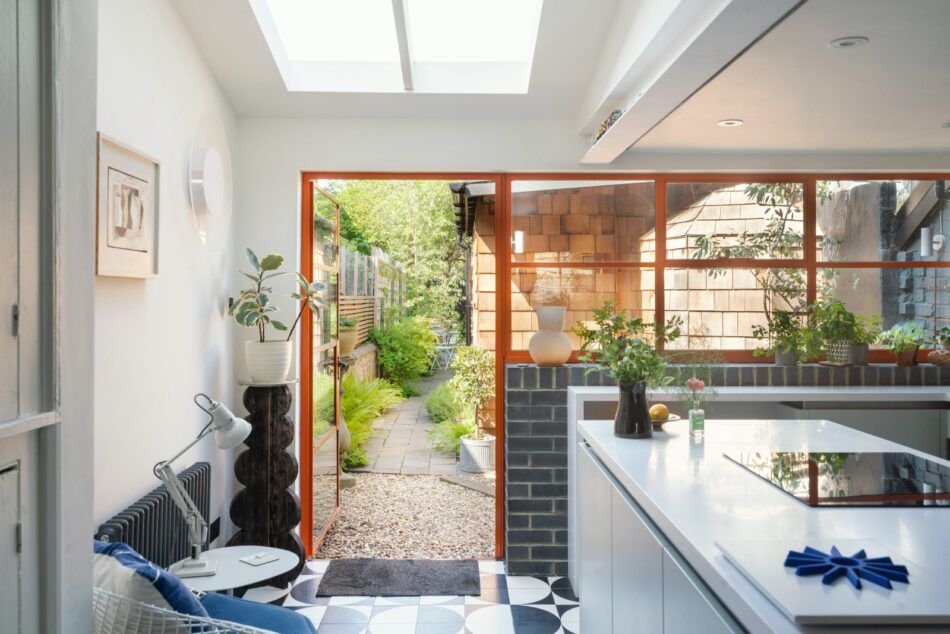
This brilliantly renovated former workers cottage is set in charming Osney, a short walk from the storied city centre of Oxford. Inspired contemporary interventions have resulted in a marriage of colour, space and light while upholding the historic bones of the original building. There are two bedrooms and a gloriously planted private garden alongside a spacious cedar clad studio/workshop. Oxford station is 10 minutes away on foot with direct links to London in around 50 minutes.
Setting the Scene
Osney town – also known as Osney Island – is a quiet community of 19th-century cottages surrounded by the River Thames and smaller streams. Protected by the Osney Town Conservation Area, it comprises of around 300 homes built to a grid design by GP Hester, a town clerk who acquired the land from Christ Church College. The tightly packed housing was built as a result of the railways and an influx of related workers to the area.
The centre of Oxford can be reached in around 10 minutes on foot. Known for what Victorian poet Matthew Arnold termed the ‘dreaming spires’, the city is shaped by its breathtakingly romantic architecture.
The Grand Tour
Set on Bridge Street, within a terrace of railway workers cottages, the house cuts a dramatic profile against the backdrop of its bare brick-clad neighbours. The façade is painted in an rich earthy red, complemented by grey six-over-six sash windows, doorway and a verdigris-coloured front door.
Colour continues within; paints are by either Farrow and Ball or mineral-based specialist Keim. The hallway opens into a bright powder-blue hallway, where the home’s modern renovation is first unveiled: the first of a series of signal-orange steel Crittall-style windows appears here, drawing in natural light to the space. Underfoot are monochromatic graphic porcelain tiles that continue into the kitchen. A complete rewire and a new roof were included in the renovations.
Recently extended, the kitchen has a predominantly white palette, save for exposed brickwork and the same orange-framed glazing that provides passage to, and views of, the garden beyond. Light blue cabinetry sits below DuPont Corian worktops, and integrated appliances include a sliding door Neff oven and microwave, a mini wine fridge, slim-sized dishwasher and a black Quooker boiling water tap. A storage island houses a Neff induction hob, and the Corian extends beneath the window to create a bar area to sit and admire the garden.
Light cascades into the space from an overhead rooflight placed in front of an exposed steel joist. An industrial appeal is continued with column radiators that appear here and throughout. There is also plenty of space for an informal dining set up next to an original fireplace with a working bioethanol fire.
The living room lies adjacent to the kitchen; between the two is a deep storage area beneath the stairs.
Additional glazing offsets the living room’s traditional feel. Its walls are washed in a dark hue that contrasts with the vibrant blue used in an original fireplace, which also has a sweet cabbages and roses design – a nod to the neighbouring waterway. There are bookshelves either side of the fireplace along with storage cupboard. Soft carpet runs underfoot, and slatted shutters have been fitted to the lower section of the sash window.
There are two bedrooms upstairs, separated by a single arch across the central staircase. Period features here include sash windows, sanded floorboards and fireplaces, both with their original grates.
The principal bedroom at the front of the plan is finished in an unctuous yellow with a recessed wardrobe; an arch here is fitted with a singular display shelf. The second bedroom is currently used as an office space.
In keeping with houses from this era, the bathroom extends directly from the latter. It has large format porcelain marble-effect tiles, a large walk-in shower and a basin above a set of drawers. Light is drawn in from an overhead Velux window and another orange-framed window.
The Great Outdoors
There is space for a small table and chairs immediately outside the kitchen in a shingled area next to the rear of the cedar-clad workshop. Orange double doors tie in with the interior scheme; the space also has extensive electricity, a sink and a WC. Its ceiling has been insulated with thick wool artfully hidden from view by reclaimed coffee sacks.
A path planted with a variety of leafy ferns leads down past the workshop into a characterful cottage garden. Trees and mature shrubs include a wonderfully productive vine in the living hedge, buckthorn, pear and birche trees. Raised planters are ideal for planting vegetables and there is a large shed at the rear of the garden for additional storage. The space has both bright and shady spots to sit outside and enjoy the warmer months.
Out and About
Osney island is short stroll in a westerly direction from the city centre via the Osney Bridge. Several footbridges connect the island across the river. The university rowing teams can be seen training next to nearby Osney Lock. There are two pubs on the island: The Punter renowned for its vegan and vegetarian fare and Hollybush. The Osney Island Residents Association organises many local events.
The city has some brilliant museums including the Ashmolean, the Pitt Rivers and Christ Church Picture Gallery. There are also several theatres and several cinemas, including the Phoenix Picturehouse in Jericho – a characterful suburb of the city close to Osney.
Port Meadow in Jericho is one of Oxford’s most picturesque spots. There are several pubs on its periphery, including popular The Perch. Other popular green spaces include Hinksey Meadows, Christ Church Meadows, University Parks and Grandpont Nature Park.
Oxford has a fantastic culinary scene, of which Gees, Arbequina and Pierre Victoire are particular standouts. The city is known for its cosy, atmospheric pubs, including The Turf Tavern and The Bear.
Oxford station is a 10-minute walk, or three-minute cycle, from the house; services run to London Paddington in as little as 52 minutes. The A40 can be easily reached for connections to the capital as well as the Chilterns.
Council Tax Band: D
For more inspiration, why not look to The Modern House’s recommendations in Oxford?
Interested? Let’s talk
Related Listings
- A Room of One’s Own: the attic studio where painter Will Calver captures the poetry of everyday lifeA room of ones own / Interiors
- A Home with a History: an enchanting antique dealer’s shop and home, painted in nature's coloursHomes / Interiors
- A Room of One’s Own: the storybook hideaway of Tess and Alfred Newall’s bow-top wagonA room of ones own / Interiors
- A Private View: the storied medieval palace on the brink of a new beginning in rural KentHomes / Interiors
- A Home With a History: the Dartmoor cottage that sparked a pioneering ceramics studioHomes / Interiors

